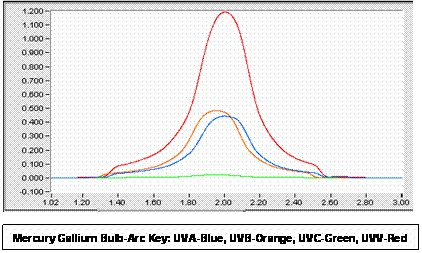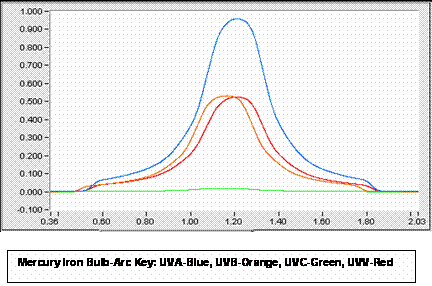Guide to UV Measurement
Advanced Multiple Band Radiometers
Multiple Band UV Radiometers contain multiple sets of optics and detectors and allow the user to simultaneously measure more than one UV bandwidth with one pass through a curing system. Instruments are available that report the energy density (J/cm²) and irradiance (W/cm²) values in one to four UV bandwidths. Multiple band Profiling Radiometers are also available that provide the energy density (J/cm²) and irradiance (W/cm²) values and the irradiance and temperature profile plotted as a function of time.
Advantages of measuring more than one UV wavelength
- With many UV applications, the shorter UV wavelengths (UVC) are responsible for surface cure characteristics (scratch, stain, chemical resistance, feel) of the product. The longer UV wavelengths (UVA, near visible-UVV) are responsible for penetration, depth of cure and adhesion to the substrate. Measuring both the shorter and longer wavelengths gives you a better picture on the performance of your system.
- Measuring and comparing the ratios of the short-wave UVC to the long-wave UVA/UVV can identify the need for maintenance. If the shorter wavelengths drop off relative to the longer wavelengths the reflector should be checked and possibly cleaned. If both the short and long wavelengths have dropped off, it may indicate aging in the bulb or other maintenance issues.
- Comparing multiple bandwidths can identify if a new or replacement lamp has been manufactured to your established or needed specifications.
- Measuring multiple wavelengths can identify the type of lamp in the UV system. If your process is using a combination of different types of bulbs, view a Sample Wood line layout, your measurements will confirm that the correct bulb has been placed in the correct location.
Multiple band ratios can be generated using the irradiance values for different bulb types as shown in a table below.
|
Mercury Bulb-Arc |
|
W/cm² |
Ratio to UVA |
|
UVA |
707 |
1 |
UVB |
601 |
0.85 |
UVC |
62 |
0.09 |
UVV |
421 |
0.60 |
|
Mercury-Iron Additive Bulb-Arc |
|
W/cm² |
W/cm² |
|
UVA |
958 |
958 |
UVB |
532 |
532 |
UVC |
18 |
18 |
UVV |
525 |
525 |
|
Mercury Gallium Bulb-Arc |
|
W/cm² |
W/cm² |
|
UVA |
444 |
444 |
UVB |
486 |
486 |
UVC |
20 |
20 |
UVV |
1194 |
1194 |
All bandwidths EIT ranges. Data collected on a 300 WPI Arc system at 40 fpm, sample rate of instrument 2048 Hz |
||
Similar results can be produced for microwave lamps but the ratios for each bulb type are slightly different.
Irradiance profiles from Multiple Band profiling radiometers allow the user to review the same information presented in the table in an easy to view graph. The graphs sometimes make it easy to identify the bulb types and to make sure they are in the correct location in a multi-lamp line. view the "Radiometry as a Tool" article


